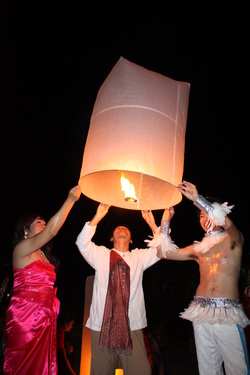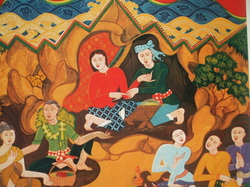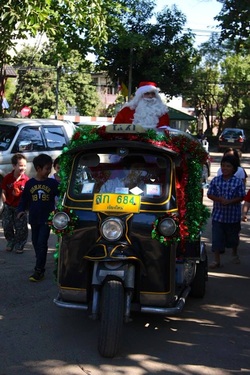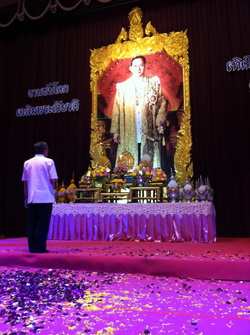 In Thailand there are countless ways to launch the New Year. In fact, there are at least 4 recognized New Year’s celebrations including the international New Year on January 1, and the Chinese New Year which comes this year on January 31. The Northern Thai (Lanna culture) New Year will be on the night of the full moon of the 12th with the national Loy Kratong festival of lights coming in 2014 on November 6, and the Central Thai traditional New Year which is a three day water-festival on April 13-15 every year. Since this is Thailand, we celebrate them all. There is no one way to observe the international New Year, but for those who are interested, which means countless thousands of people, the old year will be sent scurrying off by fire crackers and the new year launched, here in the North, by sending aloft tissue paper hot air balloons. Loy Kratong, the festival with the strongest emphasis on colored lights, is the night when most khom loy (hot air balloons) are sent into the sky. There are so many that some airlines have suspended flights that evening in and out of Chiang Mai. But a lot will be launched at midnight on December 31. Countdown parties may not match the festivities at the Sidney Harbor Bridge or in Times Square in New York City, but the New Year gets a good send-off and anybody who tries to sleep early will be awakened at midnight. Since the official launching of the New Year is at midnight, it is for people young enough to like night-life who tend to be old enough to drink. The police have a grid of checkpoints on all highways to discourage drunk driving, although it seems that mayhem prevails for an hour or two. Parties are going on everywhere, with the biggest one in Chiang Mai at the plaza in front of the Ta Pae Gate. Then on and about January 1 gift giving gets the year off to a good start. In Thai society with a strong “patron-client” tradition, the heads of schools, organizations and owners of businesses can count on being visited by their best clients, employees and students and prime customers by their grateful suppliers and merchants. It would be a good idea for children to remember their parents, too, because Thai Children’s Day is coming soon on the second Saturday of January.
0 Comments
 Jesus is Thai in this Nativity scene by Thai Christian artist Sawai Chinawong. It is a pressing spiritual matter to install core religious icons and narratives in one’s own cultural matrix. If we are born in a culture that is overwhelmingly Christian that is done for us without our having to exert ourselves very much. For Sawai easy access was not the case. Thai culture is predominantly Theravada Buddhist. Sawai had to imagine the Christmas story for himself, without much help. His painting is a bridge between the Christian Gospel and Thai culture. He chose the most direct route, using traditional temple fresco painting style. Anyone steeped in Thai classical culture, at a glance, will perceive that this is a Thai religious picture and it surely illustrates a religious narrative. When the story content makes it clear this is about the birth of Jesus, there is no need to explain that the artist is asserting that Jesus Christ is relevant to Thai people. The evangelical message is implicit in the image. How religious images and stories function spiritually and formatively is a more complex matter. The Christmas Story of the Holy Family, the shepherds and the wise men is more than a seasonal adornment. For Christians it is more than “our story”. For each of us it is also “my story” because it has helped make me who I am. It has done that by giving us metaphors to nourish and fortify us. Recently, at this stage of my senior years, I tend to clutch at the Christmas Story as a witness that God has not and will not abandon us. During my younger years the Nativity picture meant something else. The Christmas Story gives us important sustenance at whatever stage or circumstance in life we access it. A message that many young adolescents get from the Christmas Story is encouragement that things are not necessarily what they seem to be. The Christ-child in the cattle feeder had an identity the world barely perceived that silent, holy night, and kids grasp the insight that “I am not the mess people think I am, either.” BONUS NOTE: click here on The Christmas Story for more about how children assimilate the Biblical Christmas narrative and images.  Santa is the most readily recognized icon in the world, researchers say. Children who know nothing about Christmas and have no expectation of Christmas presents from Santa still know who he is. Even where there is a rival, Father Christmas or Saint Nicholas, to name two, children know Santa Claus at sight. If you put any five images on a sheet of paper (Mickey Mouse, Ronald McDonald, Doraemon, Santa, and Michael Jackson – for example) almost every child over the age of three here in Thailand can spot Santa. That, however, is pretty much where the matter rests as far as Thai kids are concerned, whereas Santa-culture kids have more ideas. Our photo downloaded from www.city-now.com entitled “Breakfast with Santa” shows the arrival of Santa by tuk-tuk at the Gymkhana Club in Chiang Mai. We can say this mode of transport would probably only happen in Thailand. A public reception for Santa arriving by some culturally specific conveyance has become a modern custom over the past few decades. It tends to indicate that Santa is back among us, here, in the present, and the pre-Christmas season is now official. Christmas as a seasonal concept is catching on in Thailand. December 25 is labeled “Christmas” on a calendar we got this year designating the Buddhist identifications of every day of the year. No shopping mall worth its salt is playing anything but Christmas background music, and there seems to be a contest to see who can construct the tallest, brightest tree-shape – the winner, of course being the mall with the tallest atrium. Of the thousands of Christian missionaries in our town, it is safe to say a majority have misgivings about the way Santa has usurped the place of the Christ-child in the Christmas spotlight. But I’m willing to give the jolly old elf his due. As I say in a book entitled Kiddy Lit I’ve just finished drafting, “Santa defies laws and expectations. That is the key to what Santa means subconsciously to children. There are elements of life that may be mysterious, predictable, relevant and unavoidable. They are not all threats, even though they come enshrouded in strangeness. …The future is fraught with the exciting possibility of the return of joy. What’s more, Santa is for kids. Kids are important no matter how powerless they are.” (Contact me if you want to know more about my progress in getting Kiddy Lit published or how to get a pre-publication copy.) Finally, I would like to insist that Santa is no more a threat to Christ than is the Hobbit. The release of the second part of the Hobbit story this week is no form of robbery of “the true Christmas”. Our children can separate Christ from Bilbo Baggins into separate categories even if their parents are too sober-minded to want them to have to, because “serious Christians” prefer everything to be in the same, single realm of discourse.  His Majesty King Bhumibol Adulyadej, Rama IX, was born 86 years ago on December 5, 1927. He ascended the throne on June 9, 1946. The King’s birthday is a national holiday in Thailand, expanded in the tenure of Prime Minister Prem Tinsulanonda into a more inclusive Father’s Day. The usual observance of the King’s birthday is a culturally unique event, conducted in thousands of locations around the country and simultaneously in Thai communities and embassies abroad. Most of the time a portrait of the King is the center of attention. In front of that, on a traditional arrangement of 9 small tables are placed bouquets of flowers and “globes” of silver and gold representing the tribute that used to be paid by loyal subjects and vassal princes. The final gift is an arrangement of candles and incense sticks with sacred flowers encased in plated banana leaves. The one presiding at the event removes the banana leaf lid ceremoniously and sometimes reads or chants a statement of homage and veneration, and often everyone lights candles if the event is being held at night. Then everyone will stand and sing the “King’s Anthem”, entitled “Sansoen Phra Barami”, which begins with the words, “Kha wora Buddha cao…” translated by somebody for Wikipedia as “We servants of His great Majesty prostrate our heart and head to pay respect to the Ruler, whose merits are boundless….” This anthem is typically played at the beginning or ending of most large public events, including movies in theaters and sporting events. Following the anthem a short medley of newer songs may be sung. Most banners and posters marking the King’s birthday will have the words, “Song Phra Charoen” which is translated, following British custom, “Long Live the King”, but more literally is the prayerful wish that the King “Prosper!” If the birthday celebration is less formal, it may include a toast with glasses raised and the three-fold intonation of “Chai-yo, chai-yo, chai-yo” very much as in English we might say, “Hip,hip HOORAY” following a leader. |
AuthorRev. Dr. Kenneth Dobson posts his weekly reflections on this blog. Archives
March 2024
Categories |
| Ken Dobson's Queer Ruminations from Thailand |
|
 RSS Feed
RSS Feed
